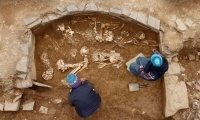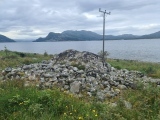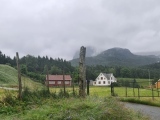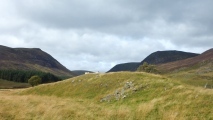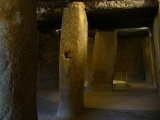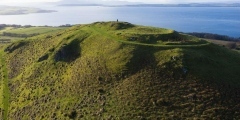Andy Burnham's Blog, page 55
August 29, 2024
Coed-Y-Gaer Hillfort (Shropshire)
An iron age hillfort in Shropshire with a single dry stone rampart. Located on a ridge on the English/Welsh border at 350m (1150ft) and covering an area of 1.5 acres, completely covered by trees. The rampart has collapsed but is still visible. There is a derelict 19th century hunting lodge at the southern end.
Published on August 29, 2024 06:46
Blomuir Chambered Tomb
Chambered tomb excavations return for another season, there's a video talk on last year's discoveries and more on our page. Recently discovered in the parish of Holm, Orkney the ruins of a 5,000-year-old tomb that 'reflects the pinnacle of Neolithic engineering'. Fourteen articulated skeletons of men, women and children – two positioned as if they were embracing – have been found inside one of six cells or side rooms. The tomb measures more than 15m in diameter and contains a stone structure accessed through a long passage of around seven metres.
Published on August 29, 2024 05:01
August 28, 2024
Staveneset cairn
This cairn is located in an almost flat area with some grass and ferns overlooking the sea to the west. The coastline along Stongfjorden has several pretty cairns and also rock art panels. A footpath goes parallel to the local road along the shore and passes several other sites. The cairn is built around an large natural block of stone which is oriented North West-South East and is 4m long in that direction.
Published on August 28, 2024 09:11
Indrehus-Gulevegen Standing Stone
Just next to a local road and down the hill from a farm is a slender and pretty standing stone. The stone is just a few metres north of the road. The placement is not original, the stone was located a little further to the south east but had to be moved when the road was built.
Published on August 28, 2024 09:11
August 27, 2024
Glenbanchor
If only .... Once it was thought that Glenbanchor near Newtonmore in the Cairngorms might be a Neolithic Long Cairn ... but no longer, "clearly a linear glacial feature" "Doubtful cairn. Probably a glacial knoll".
Published on August 27, 2024 10:20
Selworthy Beacon cairns
Several barrows, cairns and tumuli marked at the top ridge of Selworthy Beacon. On visiting in August 2024, most were obscured below the colourful heather and gorse on the top of this fabulous hill, but several lumps and bumps could be made out.
Published on August 27, 2024 10:02
August 26, 2024
Cueva de Menga
New Research Article: Early science and colossal stone engineering in Menga. "Builders of massive ancient monument understood the science behind their work."
Researchers say 6000-year-old Iberian Peninsula megalith required sophisticated knowledge of physics, geometry, and geology. More in the comments on our page. Well thought out for visitors, you are directed towards the museum first, which is a gold mine of information. Then follow the path up to the two dolmens on site (the third is a short drive away). The Dolmen de Menga is the star of the show, with its orientation and how they managed to move 180 ton stones 5000 years ago.
Researchers say 6000-year-old Iberian Peninsula megalith required sophisticated knowledge of physics, geometry, and geology. More in the comments on our page. Well thought out for visitors, you are directed towards the museum first, which is a gold mine of information. Then follow the path up to the two dolmens on site (the third is a short drive away). The Dolmen de Menga is the star of the show, with its orientation and how they managed to move 180 ton stones 5000 years ago.
Published on August 26, 2024 11:06
August 25, 2024
Northern Earth 177 is Out Now
In this issue:
• An experimental Neolithic Henge: 15 years on - John Hill looks back on the techniques and building of Liverpool’s Nesshenge
• The Alt-Antiquarian: A drift in time and space - Finding psychogeography alongside the magic in Alan Garner’s writing underlines their close association
• Luddenden, King Lud & the Luddites: Wandering in inner space - In a Pennine backwater, an armless motif seems to be on the loose, as Andrea Capstick finds
• All Things Considered: Reviews - N Yorkshire lore, Glasgow earth mysteries, Norse magic and some popular misapprehensions
• Walking the umbilicus back to source - Routeways, according to Bob Trubshaw, are much more than utilitarian material phenomena, as mindful travellers past and present know
• An experimental Neolithic Henge: 15 years on - John Hill looks back on the techniques and building of Liverpool’s Nesshenge
• The Alt-Antiquarian: A drift in time and space - Finding psychogeography alongside the magic in Alan Garner’s writing underlines their close association
• Luddenden, King Lud & the Luddites: Wandering in inner space - In a Pennine backwater, an armless motif seems to be on the loose, as Andrea Capstick finds
• All Things Considered: Reviews - N Yorkshire lore, Glasgow earth mysteries, Norse magic and some popular misapprehensions
• Walking the umbilicus back to source - Routeways, according to Bob Trubshaw, are much more than utilitarian material phenomena, as mindful travellers past and present know
Published on August 25, 2024 13:57
Cuddesdon Stones Upper
Andy B writes: This was the only known photo of this standing stone which was shockingly destroyed in or before the 1980s, but we think we have identified two more in the collection of the Tate Gallery. Photos by
John Piper (1903-1992) MD4831 and MD4832 labelled "Photograph of a Rollright stone in Oxfordshire [c.1930s-1980s]". I'm not uploading them here as the Tate want £85 per image. Anyone familiar will know they are not any of the Rollright stones but what do you think of the match here? They were identified by Mark Wallace via a call-out on Twitter.
John Piper (1903-1992) MD4831 and MD4832 labelled "Photograph of a Rollright stone in Oxfordshire [c.1930s-1980s]". I'm not uploading them here as the Tate want £85 per image. Anyone familiar will know they are not any of the Rollright stones but what do you think of the match here? They were identified by Mark Wallace via a call-out on Twitter.
Published on August 25, 2024 11:43
Knock Hill Fort
The Knock is up for sale, with 357 acres of land, 200000 trees, some carbon credit stuff and a hillfort. Knock Hill has a small Iron Age hillfort, situated upon a steep-sided ridge overlooking the Clyde estuary. The summit of the fort is surrounded by a stony, turf-covered rampart, no more than 90cm high internally. Although no trace of vitrification is currently visible, there was enough vitrified material found in the ruins to indicate that it had been a timber-laced wall.
Published on August 25, 2024 10:38


